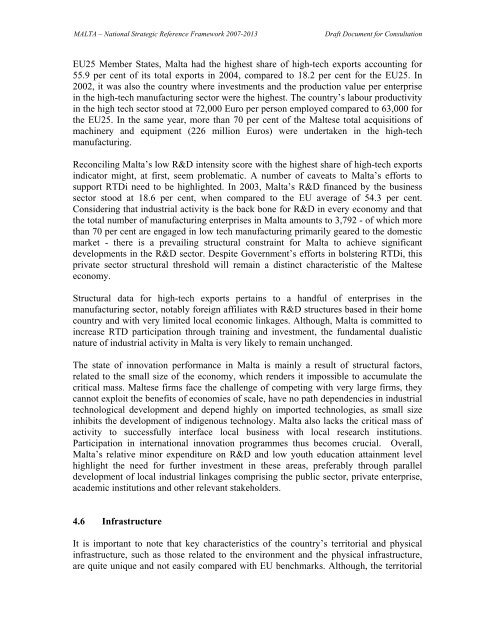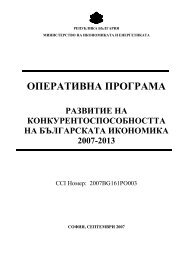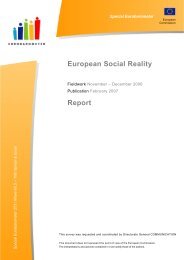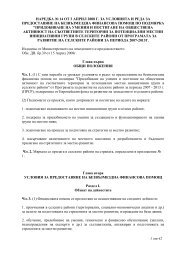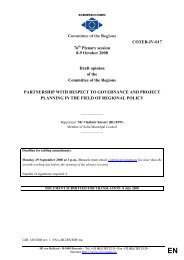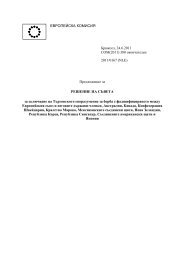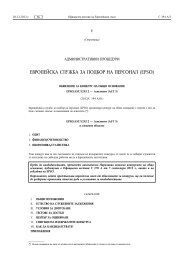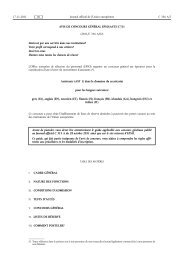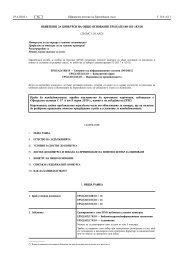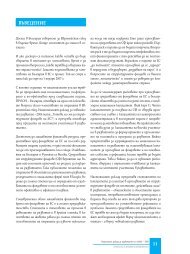National Strategic Reference Framework
National Strategic Reference Framework
National Strategic Reference Framework
You also want an ePaper? Increase the reach of your titles
YUMPU automatically turns print PDFs into web optimized ePapers that Google loves.
MALTA – <strong>National</strong> <strong>Strategic</strong> <strong>Reference</strong> <strong>Framework</strong> 2007-2013 Draft Document for Consultation<br />
EU25 Member States, Malta had the highest share of high-tech exports accounting for<br />
55.9 per cent of its total exports in 2004, compared to 18.2 per cent for the EU25. In<br />
2002, it was also the country where investments and the production value per enterprise<br />
in the high-tech manufacturing sector were the highest. The country’s labour productivity<br />
in the high tech sector stood at 72,000 Euro per person employed compared to 63,000 for<br />
the EU25. In the same year, more than 70 per cent of the Maltese total acquisitions of<br />
machinery and equipment (226 million Euros) were undertaken in the high-tech<br />
manufacturing.<br />
Reconciling Malta’s low R&D intensity score with the highest share of high-tech exports<br />
indicator might, at first, seem problematic. A number of caveats to Malta’s efforts to<br />
support RTDi need to be highlighted. In 2003, Malta’s R&D financed by the business<br />
sector stood at 18.6 per cent, when compared to the EU average of 54.3 per cent.<br />
Considering that industrial activity is the back bone for R&D in every economy and that<br />
the total number of manufacturing enterprises in Malta amounts to 3,792 - of which more<br />
than 70 per cent are engaged in low tech manufacturing primarily geared to the domestic<br />
market - there is a prevailing structural constraint for Malta to achieve significant<br />
developments in the R&D sector. Despite Government’s efforts in bolstering RTDi, this<br />
private sector structural threshold will remain a distinct characteristic of the Maltese<br />
economy.<br />
Structural data for high-tech exports pertains to a handful of enterprises in the<br />
manufacturing sector, notably foreign affiliates with R&D structures based in their home<br />
country and with very limited local economic linkages. Although, Malta is committed to<br />
increase RTD participation through training and investment, the fundamental dualistic<br />
nature of industrial activity in Malta is very likely to remain unchanged.<br />
The state of innovation performance in Malta is mainly a result of structural factors,<br />
related to the small size of the economy, which renders it impossible to accumulate the<br />
critical mass. Maltese firms face the challenge of competing with very large firms, they<br />
cannot exploit the benefits of economies of scale, have no path dependencies in industrial<br />
technological development and depend highly on imported technologies, as small size<br />
inhibits the development of indigenous technology. Malta also lacks the critical mass of<br />
activity to successfully interface local business with local research institutions.<br />
Participation in international innovation programmes thus becomes crucial. Overall,<br />
Malta’s relative minor expenditure on R&D and low youth education attainment level<br />
highlight the need for further investment in these areas, preferably through parallel<br />
development of local industrial linkages comprising the public sector, private enterprise,<br />
academic institutions and other relevant stakeholders.<br />
4.6 Infrastructure<br />
It is important to note that key characteristics of the country’s territorial and physical<br />
infrastructure, such as those related to the environment and the physical infrastructure,<br />
are quite unique and not easily compared with EU benchmarks. Although, the territorial


